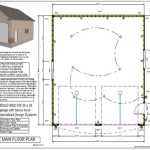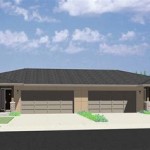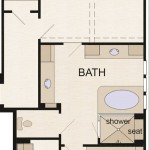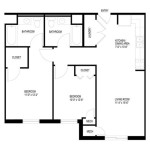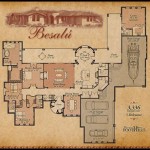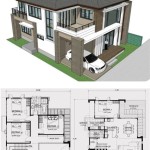2 Bedroom Semi Detached House Plans: A Comprehensive Guide
Semi-detached houses, characterized by sharing one wall with a neighboring property, offer a balanced blend of affordability, space, and privacy. They are a popular housing choice for first-time buyers, small families, and individuals seeking a more manageable property size. Among the various configurations, 2-bedroom semi-detached house plans are particularly sought after due to their practicality and cost-effectiveness. Understanding the nuances of these plans is crucial for maximizing space, functionality, and overall comfort.
This article delves into the intricacies of 2-bedroom semi-detached house plans, examining key design considerations, common layouts, factors influencing cost, and strategies for optimizing space. It intends to provide a thorough overview for those considering building or renovating a 2-bedroom semi-detached home.
Key Design Considerations for 2-Bedroom Semi-Detached Houses
Designing a 2-bedroom semi-detached house requires careful consideration of several key factors to ensure the space is functional, comfortable, and aesthetically pleasing. These considerations extend beyond the basic layout and encompass aspects such as natural light, privacy, energy efficiency, and future adaptability.
Orientation: The orientation of the house is paramount. Ideally, the living areas should be positioned to maximize sunlight exposure, particularly during the morning and afternoon. This can significantly impact the home's energy efficiency and create a more inviting atmosphere. The placement of windows should be carefully considered to capture natural light while minimizing heat gain in hotter climates. Proper orientation can also help to reduce reliance on artificial lighting, leading to lower energy bills.
Natural Light and Ventilation: Maximizing natural light is crucial in a smaller home. Large windows, strategically placed skylights, and light wells can significantly enhance the perceived size and brightness of the interior spaces. Adequate ventilation is equally important for maintaining a healthy and comfortable living environment. Cross-ventilation, achieved by placing windows on opposing walls, allows for natural airflow, reducing the need for air conditioning and preventing moisture buildup.
Privacy: Given the shared wall, ensuring privacy is a key consideration. Noise insulation measures, such as soundproof walls and double-glazed windows, can minimize disturbances from the neighboring property. The placement of windows and doors should also be carefully considered to prevent overlooking and maintain a sense of privacy within the living areas and bedrooms. Utilizing landscaping, such as strategically placed trees and shrubs, can further enhance privacy from the street and neighboring properties.
Space Optimization: Every square foot counts in a 2-bedroom semi-detached house. Smart storage solutions, multi-functional furniture, and open-plan layouts can help to maximize the use of available space. Built-in wardrobes, under-stair storage, and loft conversions are popular options for creating additional storage space. Open-plan living areas can create a sense of spaciousness and improve the flow of movement throughout the house.
Accessibility: Consideration should be given to accessibility, particularly for individuals with mobility issues or those planning to age in place. Wider doorways, ramps instead of steps, and accessible bathrooms can make the home more user-friendly for people of all ages and abilities. Future-proofing the design to accommodate potential accessibility needs can increase the long-term value and desirability of the property.
Energy Efficiency: Incorporating energy-efficient features is essential for reducing utility bills and minimizing environmental impact. High-performance insulation, energy-efficient windows and doors, and solar panels can significantly reduce energy consumption. Using sustainable building materials and incorporating passive solar design principles can further enhance the home's energy efficiency. A well-designed and energy-efficient home is not only more comfortable but also more cost-effective to operate.
Aesthetics and Style: The aesthetic appeal of the house is a matter of personal preference. However, it's important to choose a style that is appropriate for the neighborhood and reflects the homeowner's individual taste. Modern, traditional, and contemporary styles are all popular choices for 2-bedroom semi-detached houses. The exterior design should complement the surrounding architecture and create a visually appealing facade. The interior design should be functional, comfortable, and reflect the homeowner's personal style.
Common 2-Bedroom Semi-Detached House Layouts
There are several common layout variations for 2-bedroom semi-detached houses, each with its own advantages and disadvantages. The optimal layout will depend on the specific needs and preferences of the occupants, as well as the size and shape of the building plot. Understanding these common layouts can aid in making informed decisions during the design process.
Traditional Layout (Two Stories): This layout typically features a living room, kitchen, and dining area on the ground floor, with two bedrooms and a bathroom on the first floor. This is a classic and functional layout that provides a clear separation between living and sleeping areas. The staircase usually occupies a central position in the house, providing access to the upper floor. This layout is well-suited for families with young children, as it allows for easy supervision of the children's bedrooms from the living areas.
Open-Plan Ground Floor Layout (Two Stories): This variation features an open-plan living, kitchen, and dining area on the ground floor, creating a more spacious and sociable living environment. The two bedrooms and bathroom are located on the first floor. This layout is popular for its modern and contemporary feel. The open-plan design can make the house feel larger and brighter, and it is ideal for entertaining guests. However, it can also be less private than the traditional layout, as there is less separation between the different living areas.
Bungalow Layout (Single Story): A bungalow layout features all the living areas, including the two bedrooms and bathroom, on a single level. This layout is particularly suitable for individuals with mobility issues or those planning to age in place. Bungalow layouts can be more expensive to build than two-story houses, as they require a larger building plot. However, they offer the advantage of being easier to maintain and navigate.
Reverse Living Layout (Two Stories): This layout features the living areas on the first floor and the bedrooms on the ground floor. This design is often used in coastal areas to take advantage of views from the upper floor. The living areas benefit from increased natural light and better views, while the bedrooms are cooler and more private on the ground floor. This layout is less common than the traditional layout but can be a good option for maximizing views and creating a unique living environment.
Split-Level Layout: This layout features living areas on different levels, connected by short flights of stairs. This can create a more dynamic and interesting living space. Split-level layouts can be used to separate different living areas and create a sense of privacy. However, they can also be less accessible for individuals with mobility issues.
The specific dimensions and configuration of each room will vary depending on the overall size of the house and the design preferences of the homeowner. However, these are some of the most common layout variations for 2-bedroom semi-detached houses.
Factors Influencing the Cost of 2-Bedroom Semi-Detached House Plans
The cost of building or renovating a 2-bedroom semi-detached house can vary significantly depending on several factors. Understanding these factors is essential for budgeting effectively and making informed decisions throughout the construction or renovation process.
Location: The location of the property is one of the most significant factors influencing cost. Land prices vary widely depending on the area, with urban areas generally being more expensive than rural areas. Labor costs also vary depending on location, with some areas having higher rates for construction workers and other tradespeople. The cost of materials may also vary depending on the distance from suppliers.
Size and Complexity of the Design: The size and complexity of the house design will also affect the cost. A larger house will require more materials and labor, increasing the overall cost. Complex designs with intricate architectural features will also be more expensive to build. Simple, rectangular designs are generally more cost-effective than more elaborate designs. The number of windows, doors, and other openings will also affect the cost. Larger windows and custom-made doors can significantly increase the budget.
Materials Used: The choice of building materials can have a significant impact on the cost. High-end materials such as hardwood flooring, granite countertops, and custom cabinetry will be more expensive than standard materials such as laminate flooring, laminate countertops, and stock cabinetry. The use of sustainable building materials may also increase the cost, although these materials can often provide long-term savings through reduced energy consumption.
Labor Costs: Labor costs can represent a significant portion of the overall cost of building or renovating a house. Labor rates vary depending on the skill and experience of the tradespeople involved. Hiring experienced and qualified professionals is essential for ensuring a high-quality finish, but it may also be more expensive. Getting multiple quotes from different contractors is recommended to compare prices and find the best value.
Fixtures and Fittings: The choice of fixtures and fittings, such as lighting fixtures, plumbing fixtures, and appliances, can also affect the cost. High-end fixtures and fittings can significantly increase the budget. Choosing energy-efficient appliances can help to reduce long-term energy costs.
Permits and Inspections: Building permits and inspections are required for most construction and renovation projects. The cost of these permits and inspections can vary depending on the local regulations. It's important to factor these costs into the budget.
Contingency Fund: It is always advisable to set aside a contingency fund to cover unexpected costs that may arise during the construction or renovation process. A contingency fund of 10-15% of the total project cost is generally recommended.

12 Semi Detached House Plans Ideas Duplex Floor

2 Bedroom Semi Detached House Plans Bungalow Floor Free Flooring

Floor Plan Of My 2 Bedroom Semi Detached Properties

Two Bedroom Semi Detached House Model Construction Documents And Templates

12 Semi Detached House Plans Ideas Duplex Floor

Two Bedroom Semi Detached Duplex 200 Sqm

Two Bedroom Semi Detached House Model Construction Documents And Templates

Pin Page

Two Bedroom Semi Detached Duplex 200 Sqm

Semi Detached House Plans And Duplex Drummond


